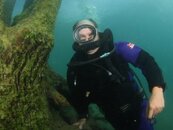Bigd2722
Contributor
I'll double check, but I wear a 7mm FJ during the cold months in Florida, but I don't remember having a problem
Welcome to ScubaBoard, the world's largest scuba diving community. Registration is not required to read the forums, but we encourage you to join. Joining has its benefits and enables you to participate in the discussions.
Benefits of registering include
The OP is learning to dive in a cold water quarry wearing lots of neoprene. This is something that takes practice, preplanning and proper weighting. Once it gets away from you, you are a cork. I dive the same quarry and initially had the same issues with many more dives than he has to date.
I recommend he practice his ascents alongside one of the platform lines. He will be able to check a runaway ascent, adjust his buoyancy and continue the ascent. Remember you want ideally to stay neutral and rise on slight fin actions. If you stop finning and continue to rise or sink, you are not neutral.
Keep practicing. BTW you will be amazed how easy it is in warm water with a thin suit.
You would not likely have made it off of the bottom. Not at 80 feet.
Why? I never put any air in my BC underwater. I weight myself for depth and wetsuit thickness. I swim down, swim around and swim up. Old school. No problems with ascent.

From your posting history you dive a 5mm Neosport and from your profile pic I can see how that is working out for you. Your trim is so vertical that it looks like you are practicaly walking along the bottom. BTW, don't you think your SPG hose is a bit long? Good news is it doesn't look like you need to worry about it dragging along the bottom.
View attachment 127378
Why? I never put any air in my BC underwater. I weight myself for depth and wetsuit thickness. I swim down, swim around and swim up. Old school. No problems with ascent.

